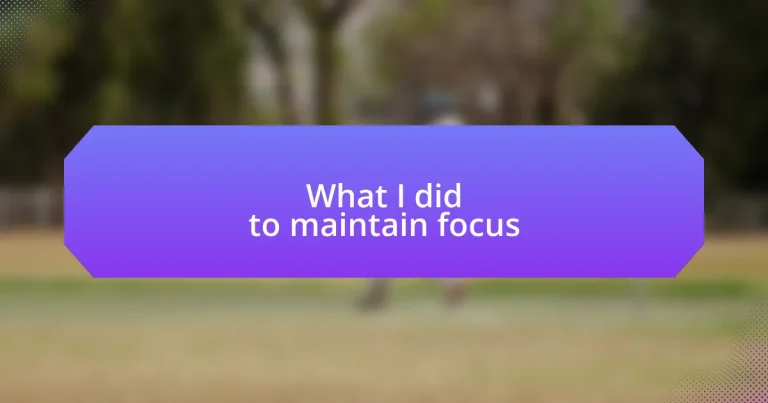Key takeaways:
- Focus is crucial for productivity and satisfaction; techniques like time-blocking can enhance attention.
- Common distractions include phone notifications, clutter, and background noise; awareness of these can help mitigate their effects.
- Creating an effective workspace with natural light and organization significantly boosts concentration levels.
- Regular reflection and adaptation of strategies improve focus; mindfulness practices can also support sustained attention over the long term.
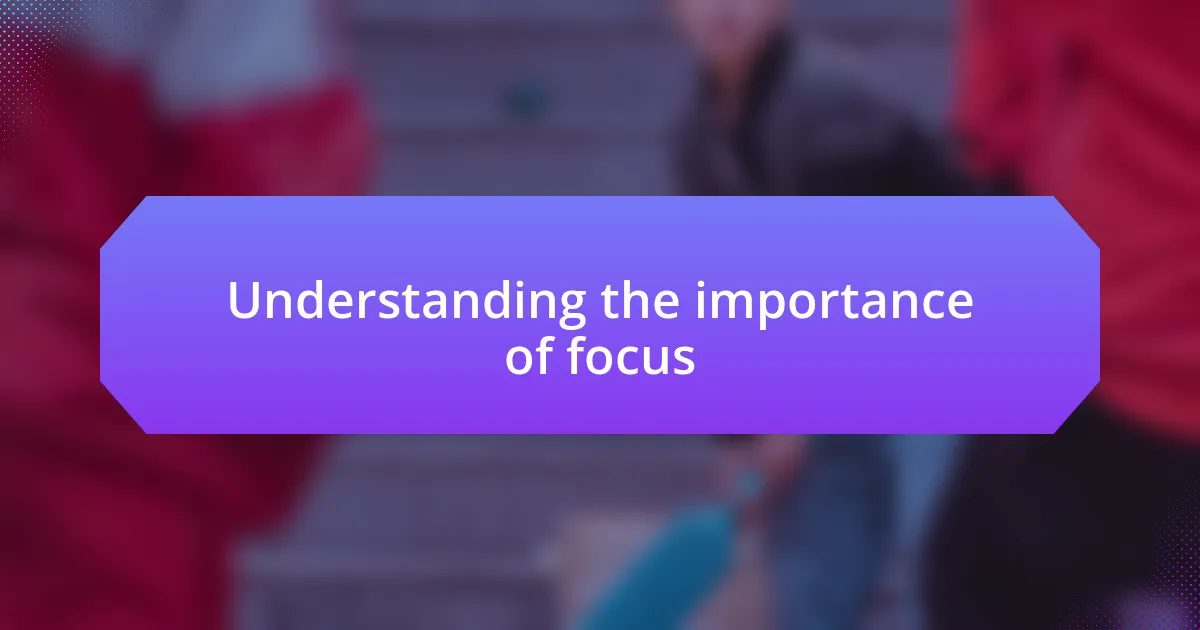
Understanding the importance of focus
Focus is truly the cornerstone of productivity and achievement. I remember times when I struggled to concentrate, often feeling overwhelmed by distractions. Have you ever felt that your mind is racing in a hundred different directions? In those moments, I realized that my ability to focus directly impacted my output and overall satisfaction in my work and personal life.
When I learned to harness focus, everything changed for me. Whether it was during a crucial meeting or while diving into creative work, the depth of engagement I experienced was incredible. It made me question: how often do we allow unnecessary distractions to rob us of our clarity and potential? I find that prioritizing focus allows not just for clearer thinking but also for deeper connections with the tasks and people around me.
Understanding the importance of focus can transform how we approach our daily lives. For instance, I’ve implemented small practices that support sustained attention, such as time-blocking my schedule. This method doesn’t just help me maintain efficiency; it also brings a sense of accomplishment at the end of the day. Focus isn’t merely about getting things done; it’s about enriching our experience in whatever we choose to pursue.
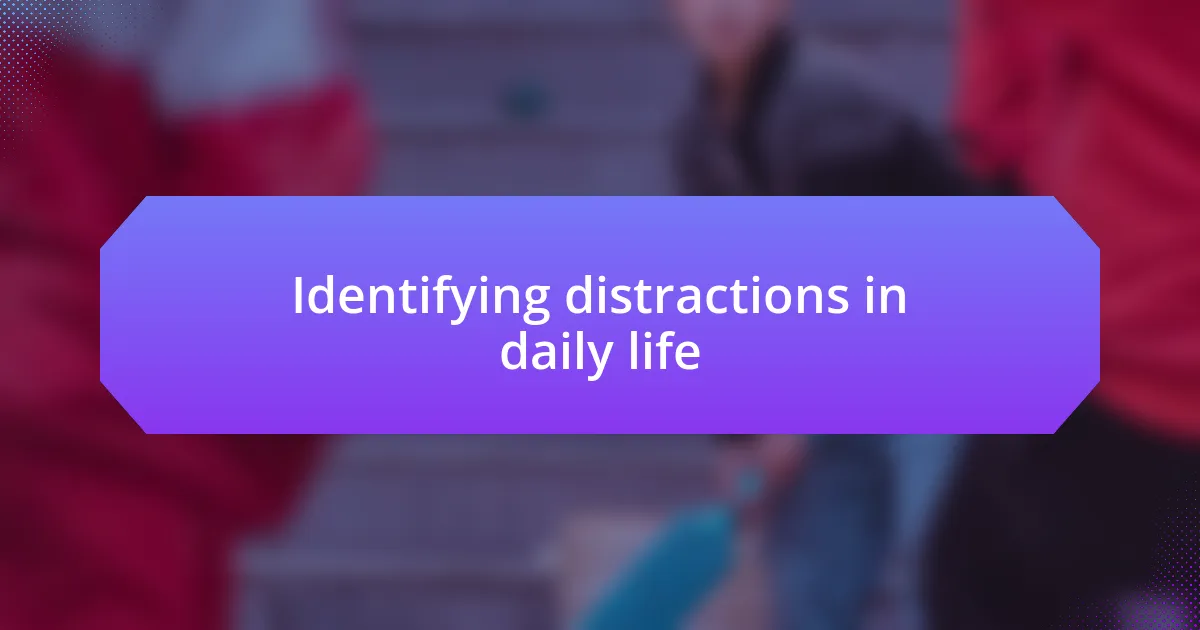
Identifying distractions in daily life
Distractions lurk in every corner of our daily life, sometimes appearing where we least expect them. I remember a time when I’d sit down to work, only to be bombarded by notifications from my phone. Each ping felt like a siren call, pulling my attention away from the task at hand. It wasn’t just the phone; environmental factors, like the hum of conversations around me or the clutter on my desk, also chipped away at my concentration.
To effectively identify these distractions, I’ve found it helpful to keep a running list of what pulls me away from my focus. Here are common distractions I noticed impacting my daily rhythm:
- Phone notifications and social media
- Background noise and conversations
- Cluttered workspaces
- Interruptions from family or colleagues
- Internal distractions like wandering thoughts or stress
Recognizing these triggers has been a game-changer for me. By being aware of them, I can actively mitigate their impact, creating a more conducive environment for concentration.
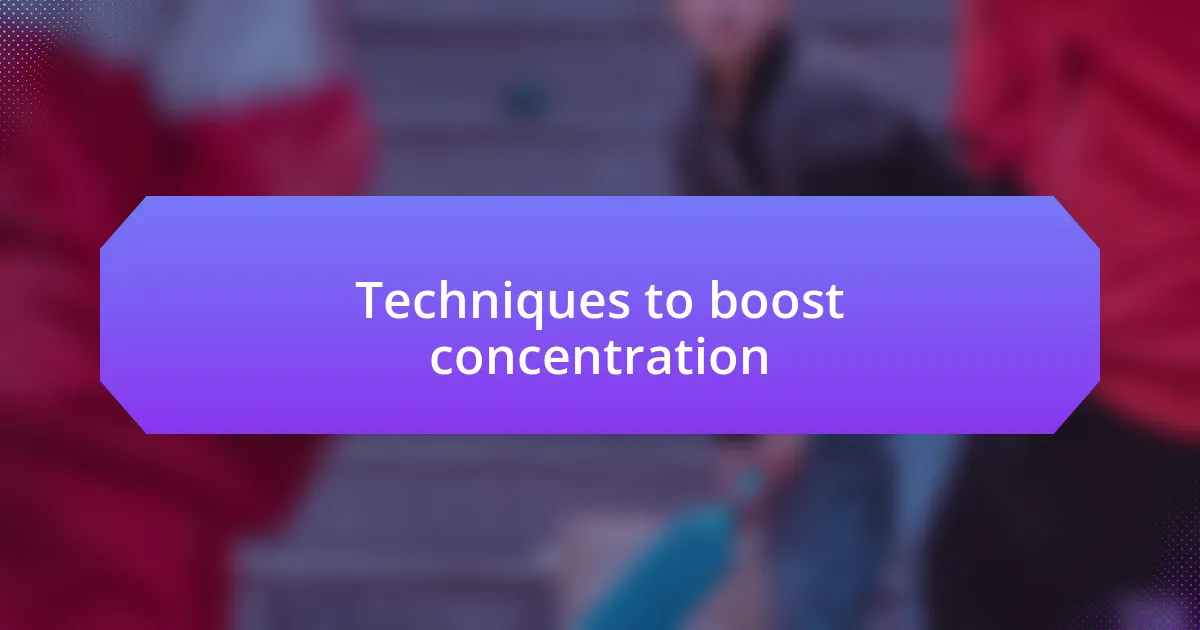
Techniques to boost concentration
Maintaining focus often requires consciously adopting techniques that enhance concentration. One method I’ve found effective is the Pomodoro Technique, where I work in timed intervals, usually 25 minutes, followed by a short break. This approach not only carves work into manageable chunks but also provides a refreshing pause to recharge my mind. I remember the first time I used this method—I was amazed at how productive I felt after just a few cycles.
Another technique involves creating a designated, clutter-free workspace. Over the years, I’ve realized how much my environment influences my ability to concentrate. When I set up a specific spot for work, free from distractions and organized neatly, it signals to my brain that it’s time to focus. I can’t stress enough how transformative this has been for me. There’s a certain clarity that comes when I sit down to a clean desk, which instantly improves my concentration levels.
Mindfulness practices also play a key role in boosting my concentration. I take just a few minutes each day to practice deep breathing or meditation; it’s like hitting the refresh button in my mind. I recall a time when overwhelming thoughts clouded my focus. After integrating mindfulness sessions into my routine, I found that I could navigate through my tasks with a clearer, more attentive mindset.
| Technique | Description |
|---|---|
| Pomodoro Technique | A method using timed work intervals followed by short breaks to enhance focus. |
| Clutter-free Workspace | Creating an organized and designated work area to eliminate distractions and improve concentration. |
| Mindfulness Practices | Engaging in deep breathing or meditation to clear the mind and increase attentiveness. |
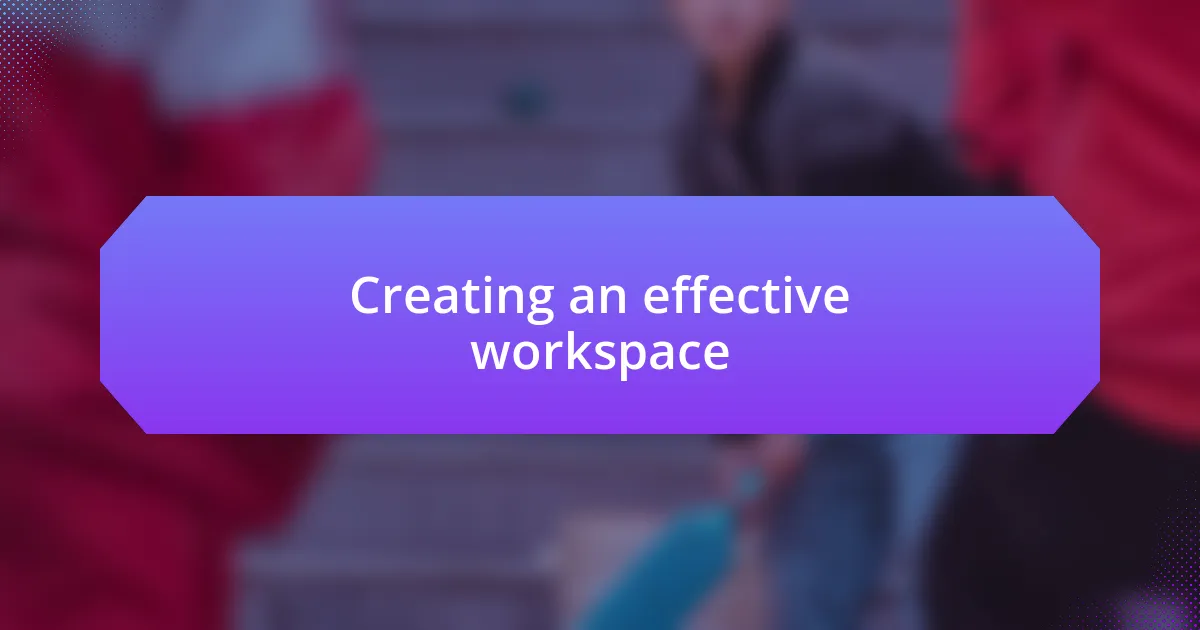
Creating an effective workspace
Finding the right workspace has been a game changer for me. I often rearrange my desk, adding elements that inspire me—like plants or artwork. Each time I make these changes, I feel a renewed sense of purpose, as if I’m creating an environment that reflects my productivity goals. Does the atmosphere you work in significantly affect your focus?
Lighting, I’ve found, plays a crucial role in crafting the perfect workspace. Natural light boosts my mood and energy levels, while harsh artificial lighting can make me feel drained. I remember when I switched my workspace closer to a window; that simple change turned my work sessions into invigorating experiences. Have you noticed how different lighting affects your concentration?
I’ve made it a habit to declutter my space every week. There’s something cathartic about clearing away unnecessary items, almost like wiping the slate clean for creativity and focus. I feel much more mentally prepared when my area is tidy, and it eliminates distractions that could easily pull me away from my tasks. What’s more motivating than knowing you have a serene place to dive into your work?
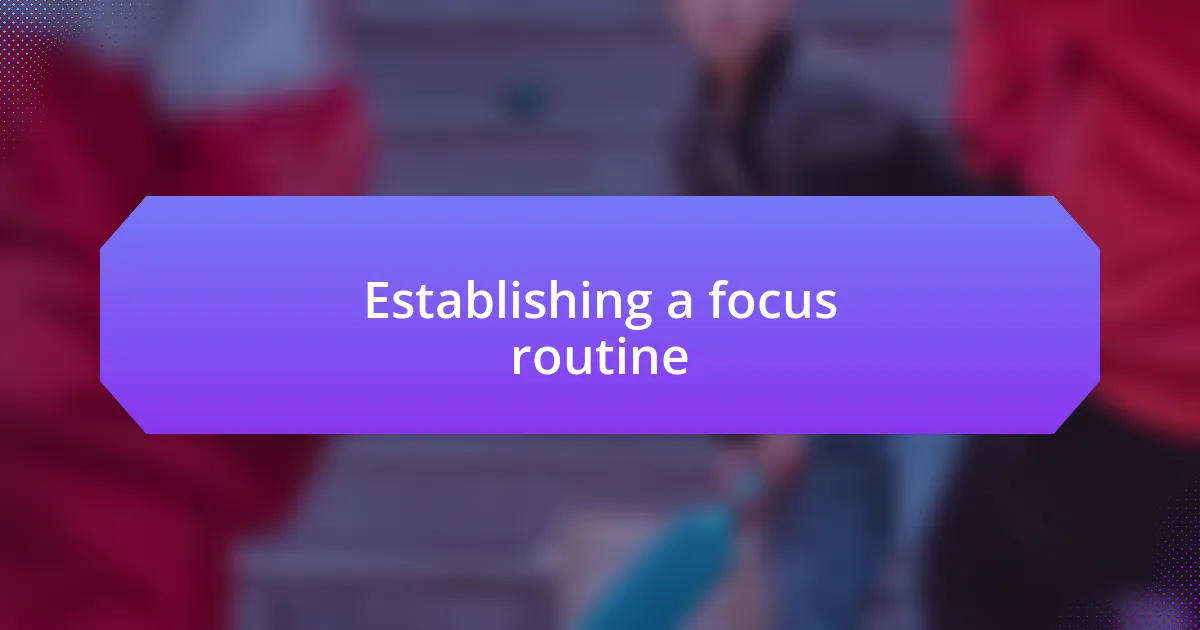
Establishing a focus routine
Establishing a focus routine has been a pivotal step in my productivity journey. Every morning, I allocate a specific time to plan my day, prioritizing tasks based on urgency and importance. I’ve noticed that this ritual helps center my thoughts, making me less likely to drift into distractions throughout the day—what rituals do you follow to set your focus?
In my experience, timing is everything. I adopted the Pomodoro Technique, which involves working in focused bursts followed by short breaks. Initially, it felt odd to break my concentration, but I soon realized these breaks rejuvenated my mind, allowing for deeper focus when I returned. Have you ever tried a timed approach to your work?
Another key element is creating a consistent environment for my routine. I use the same music playlist during work sessions, which signals my brain that it’s time to concentrate. It’s interesting how specific sounds can trigger focus; it’s like I’m training my brain to switch gears. How do you tailor your environment to signal it’s time to dive deep into your work?
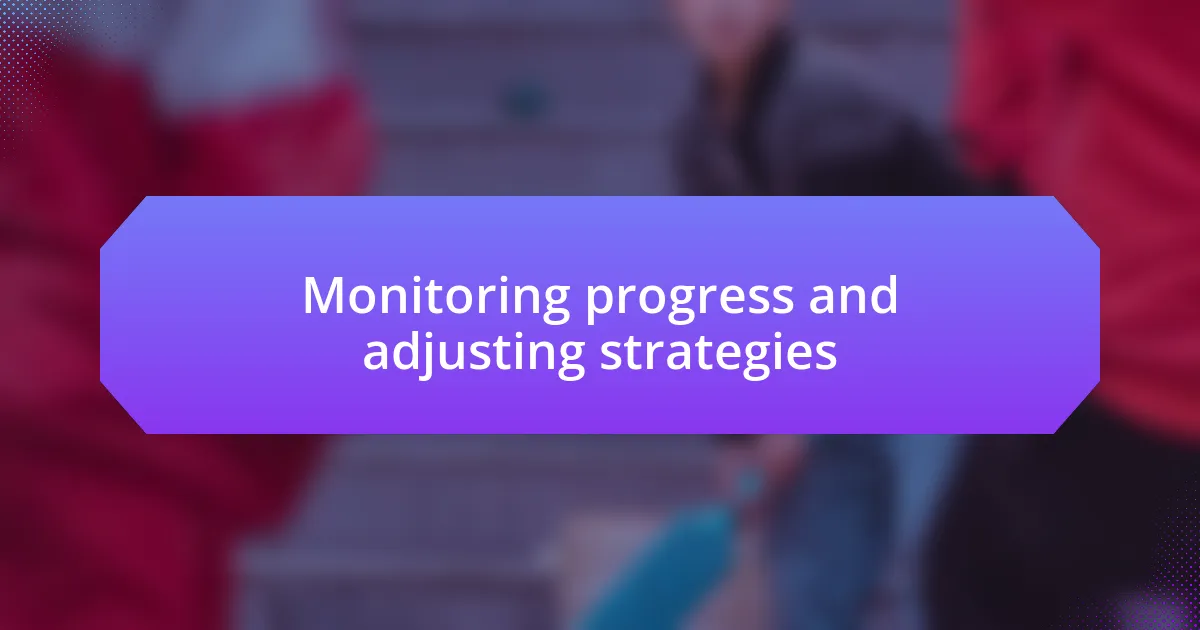
Monitoring progress and adjusting strategies
Monitoring progress is essential for staying on the right path. I often take a moment at the end of each day to review what I accomplished and what I didn’t. Reflecting on these outcomes helps me pinpoint areas that may need a different approach. Have you ever reflected on your progress and realized a simple tweak could lead you to your goal more efficiently?
Adjusting strategies based on what I see is equally important. Last month, I found myself stuck on a project, repeatedly hitting a wall. After analyzing my progress, I decided to switch my environment for a few sessions. That change not only re-energized my mindset but also led to breakthroughs I hadn’t anticipated. What changes could you implement when you feel stagnated in your work?
I also keep an open line of communication with fellow colleagues or friends who understand my goals. Sharing my challenges and discussing strategies allows me to gain fresh perspectives. There have been times when their insights reshaped my approach completely, reminding me how collaboration can elevate focus. Have you tapped into the power of discussions to refine your strategies?
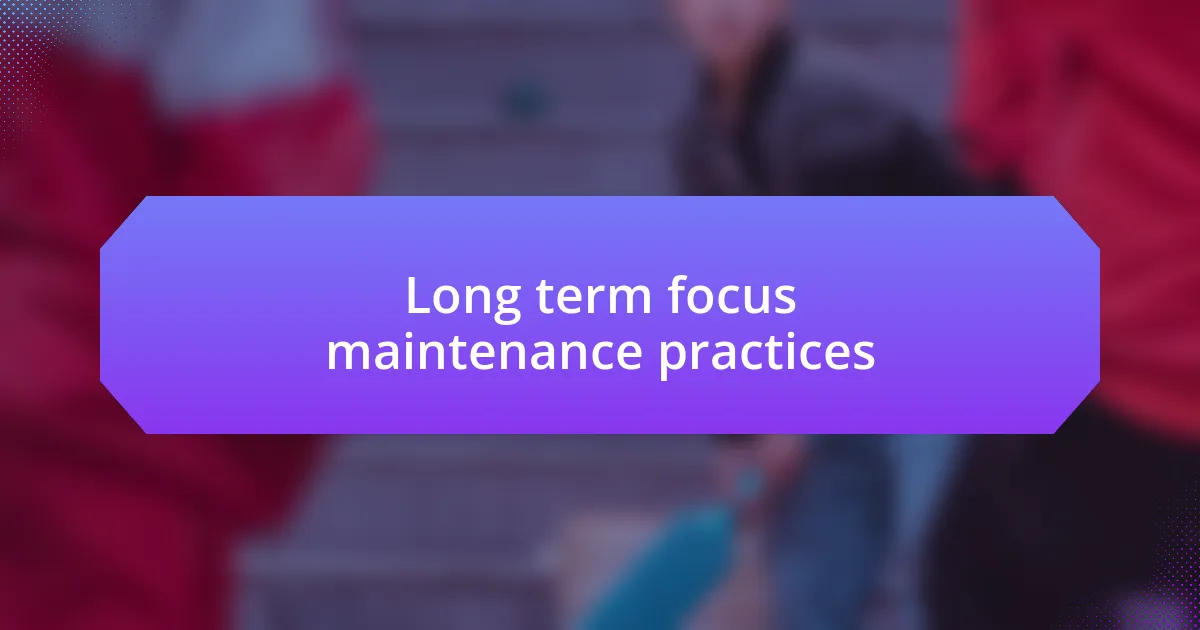
Long term focus maintenance practices
Long-term focus maintenance requires consistent habits that support sustained attention and clarity. I’ve discovered that setting regular review periods, such as weekly check-ins with myself, keeps my focus sharp. During these moments, I take stock of my goals and assess what strategies are working, which often leads me to unexpected realizations about my priorities. Have you ever found that reflecting on your week can bring important shifts in your perspective?
Another practice I’ve adopted is the use of mindfulness techniques, which help create a mental buffer against distractions. In my experience, carving out just ten minutes a day for meditation dramatically improves my ability to concentrate on projects. This simple ritual not only grounds me but also enhances my creativity, making it easier to tackle complex problems. Have you tried incorporating mindfulness into your routine to see how it impacts your focus?
Finally, I find that creating a supportive physical environment is crucial for maintaining long-term focus. I’ve rearranged my workspace multiple times, each adjustment fine-tuning my ability to concentrate. For example, when I added plants and natural light to my office, I felt an instant boost in my motivation and productivity. How might your environment be influencing your focus, and what changes could help make it more conducive to long-term concentration?












